In my previous article – What is a hybrid solar inverter? – I showed the characteristics of three types of inverters: off-grid, grid-tie and hybrid. The main conclusion of the article is that the hybrid inverter is one that can operate in both modes: off-grid and grid-tie.
Furthermore, in that article I explained that on-grid mode (also known as grid-tie) is specifically the operating mode in which the inverter behaves as a bidirectional current source, being able to inject or withdraw energy from the electrical grid.
If the inverter does not have the ability to operate in this mode, it is not a hybrid. In this article, we will talk in more detail about the off-grid inverter-charger, which was slightly mentioned in the previous article.
And let's try again to clarify the confusion that exists in the market around the name “hybrid”. The confusion is just a matter of terminology or nomenclature. The inverters shown in Figures 1 and 2 are clearly different.
It is preferable to reserve the term “hybrid” for the inverter in Figure 1, while the inverter in Figure 2 deserves to be called just an off-grid inverter-charger. The inverters shown in the figures are from the manufacturer PHB. The company calls its inverter-charger “off-grid” and its on/off-grid inverter “hybrid”. There is no room for doubt about what each thing is.
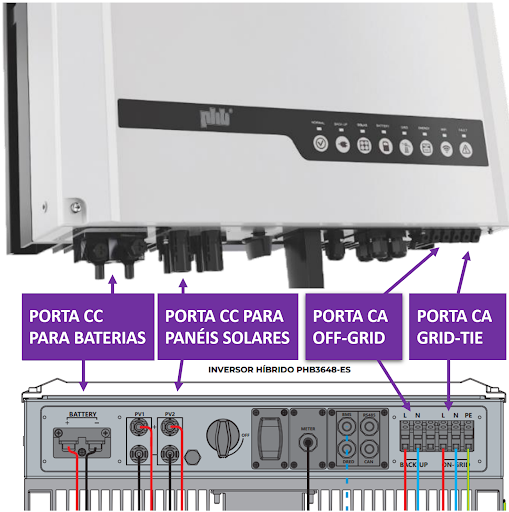
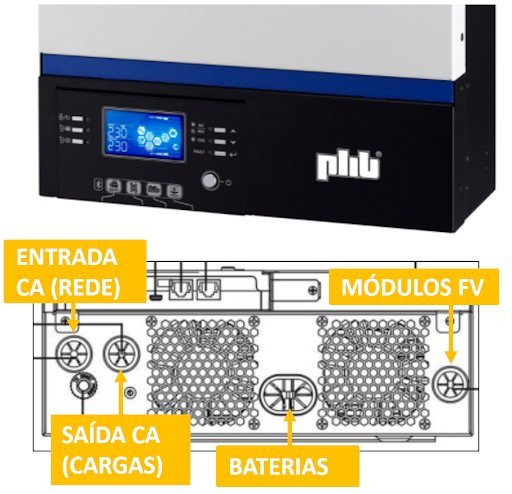
On/off-grid hybrid inverter
The hybrid inverter in Figure 1 has two DC input ports and two AC ports – one off-grid and the other grid-tie – as illustrated in Figure 3. For most of the time this inverter will operate as a conventional grid-tie , connecting to the network via the bidirectional AC port.
In fact, there is a difference compared to the conventional grid-tie inverter. This inverter, in addition to injecting energy from the solar panels into the electrical grid, has the ability to exchange energy from the batteries with the electrical grid (charging or discharging them). This mode of operation with the exchange of battery energy with the electrical grid is not yet regulated in Brazil (but will be soon).
On the other hand, when there is no electrical grid, the inverter switches to off-grid mode, supplying voltage to its unidirectional AC port. In this case, the inverter operates completely disconnected from any electrical network and its unidirectional AC port behaves as a voltage source.
Loads connected to this port can be powered during a grid failure, as long as there is power in the batteries. Normally, when we design a hybrid system, we connect loads that are priority or essential to the off-grid port (for example: lighting, sensitive equipment, computers).

The illustrations in Figure 4 show the different operating modes of the hybrid inverter. These illustrations were taken from the “Photovoltaic hybrid inverter user manual – ES Line”, from PHB.
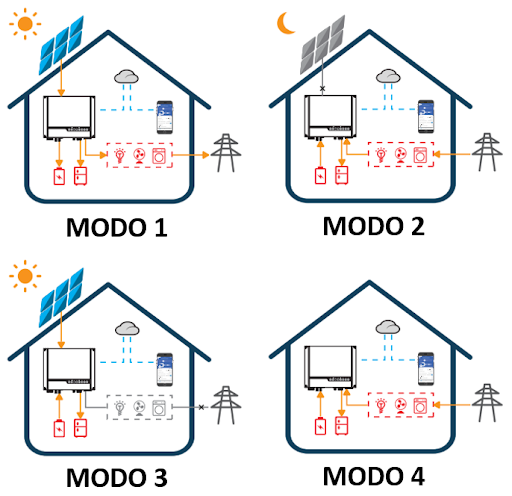
Mode 1: The energy produced by the PV system is used to optimize self-consumption. Excess energy is used to recharge the batteries and any remaining energy is exported to the grid.
Mode 2: When there is no PV power and battery power is sufficient, the system can meet the load supply together with grid power.
Mode 3: When the network fails, the system automatically switches to standby mode. The backup load can be supported by PV energy and battery.
Mode 4: The battery can be charged from the network.
Off-grid inverter-charger
The inverter in Figure 2 operates only in off-grid (voltage source) mode. It is not capable of injecting energy into the electrical grid. It can charge the batteries with energy from solar panels or the electrical grid. If there is no solar energy available, you can power the loads with power from the electrical grid (if it is present) or from batteries (if the grid fails) – this is exactly what a UPS does.
Figure 5 shows that the off-grid inverter-charger has three input ports, two DC and one AC. The AC input port is only used to charge the batteries or power the loads connected to the AC output port from the mains (if it exists).
The AC output port, in turn, can have a direct connection to the electrical network (this depends on each equipment) or can operate 100% of the time as a voltage source through a DC-AC converter, supplying only the loads to connected – with energy that can come from the electrical grid itself, batteries or solar panels.
Regardless of the internal configuration of the equipment, the AC output port will always be a voltage source type port. In the absence of the electrical grid, the AC output port powers the loads exclusively with energy from batteries or solar panels, like an authentic off-grid inverter with an internal charge controller.
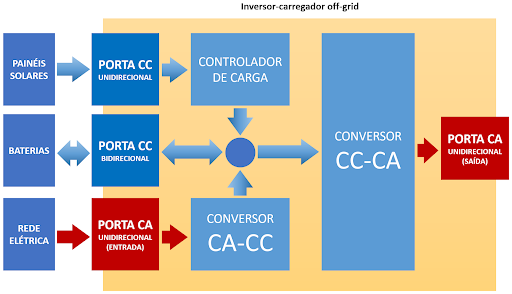
Figure 5 also shows the internal functioning of the off-grid inverter-charger. In this case we are exemplifying the inverter known as online or double conversion (terminology used in the world of UPS).
In this equipment, the off-grid port will always supply the loads through a DC-AC converter, even if the electrical grid is present. In other words, the loads will never be connected directly to the grid. All energy delivered to the loads will be processed by the DC-AC inverter.
If the AC input port of the inverter-charger is connected to the electrical network, its function is to supply the batteries or loads through an AC-DC rectifier. This port never injects energy into the electrical grid – therefore, it is not a grid-tie port like the hybrid inverter in Figure 1.
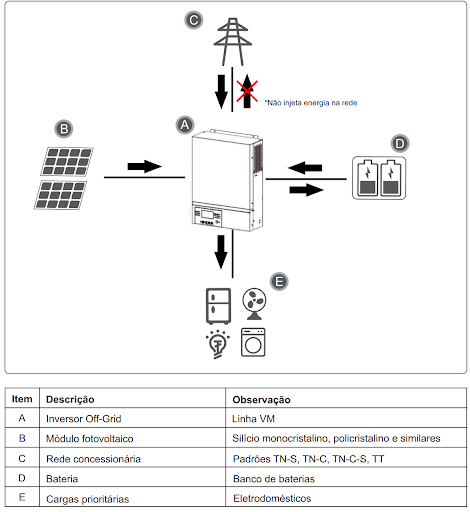
Figure 6 illustrates the off-grid inverter-charger connection mode, taken from the PHB VM line inverter-charger manual. The manual leaves no doubt about the operation of the AC input port, which receives the connection from the electrical network: it is a unidirectional input port, which is not capable of injecting energy into the electrical network (i.e., it does not operate in grid-tie mode).
Hybrid or off-grid: the origin of the confusion
Figure 7 illustrates a connection diagram for an off-grid inverter-charger from a generic manufacturer.
The information on the manufacturer's website is quite confusing and incomplete. The product is called “3kw Pure Sine Wave Solar Controller Mppt Inverter For Home” (sic), but in some parts of the website it is referred to as “hybrid”. People with no knowledge of inverters may purchase the equipment thinking that it is a truly hybrid inverter, which can operate in on-grid and off-grid modes.
Ultimately, the term hybrid could (according to a small strand of opinion in the market) be used here due to the fact that the equipment has inputs for different sources and energy stores: solar panels, batteries and electrical grid or generator. However, this is not the definition of “hybrid” that we like to use.
The information shown by the manufacturer is not clear. No manual or datasheet is available on the website. Confirmation of the type of inverter can be done by connecting the AC input (green line in Figure 7), whose arrow indicates only a unidirectional energy flow. It is, quite simply, a port for charging batteries or supplying loads from the electrical network or an external generator.
In summary: this inverter does not operate in grid-tie mode and resembles the one in Figure 2, which we call an off-grid inverter-charger.

Conclusions
In this article, two types of inverters were shown: on/off-grid hybrid inverter and off-grid inverter-charger. We can conclude that the hybrid inverter is one that operates in on and off-grid modes, while the inverter-charger operates only in voltage source mode (at the AC output).
The off-grid inverter-charger has a unidirectional AC input that does not work in grid-tie mode and only serves to power the batteries or loads if the grid is present.
If it is off-grid, the inverter-charger is just an off-grid inverter with an integrated charge controller (for the solar panels). If it is connected to the grid and disconnected from the solar panels, the inverter charger works exactly like a UPS.
In any situation, regardless of different opinions on the nomenclature to be adopted, the inverter-charger will never be an on/off-grid hybrid. The market lacks a clear definition and nomenclature of what a hybrid inverter is, differentiating it from an off-grid inverter-charger, so that users and designers are clear about the functions, purposes and modes of use of each type of equipment. .
References
- Photovoltaic Hybrid Inverter User Manual – ES Line, PHB
- User manual – VM line – off-grid solar inverter, PHB
- Hybrid PV Inverter Datasheet, PHB
- Off-grid Solar PV Inverter Datasheet, PHB
- https://www.energiasolarphb.com.br/produto/inversor-phb3048-vm
- https://www.energiasolarphb.com.br/inversores-onoff-grid
- http://www.sunchees.com
















2 Responses
wish More information about the hybrid inverter
Hello, José, how are you? Check out the videos on our YouTube channel: https://youtu.be/rn8VGp2MPJk | https://youtu.be/TTemn1_AtME